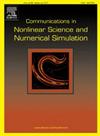Modified L1 Crank–Nicolson finite element methods with unconditional convergence for nonlinear time-fractional Schrödinger equations
IF 3.4
2区 数学
Q1 MATHEMATICS, APPLIED
Communications in Nonlinear Science and Numerical Simulation
Pub Date : 2025-01-20
DOI:10.1016/j.cnsns.2025.108623
引用次数: 0
Abstract
The paper focuses on numerically solving the nonlinear time fractional Schrödinger equations. The modified Crank–Nicolson scheme is used for the time discretization and the Galerkin finite element approximation is used in the spatial direction. Besides, we provide the proofs of stability by mathematical induction and unconditionally optimal error estimates by a discrete fractional Grönwall inequality derived in this paper, Sobolev embedding theorems and some other inequalities for the fully discrete linearized modified Galerkin finite element scheme. Furthermore, a transformed Crank–Nicolson Galerkin finite element method based on the change of variable is constructed on the uniform space–time mesh for solving the nonlinear time fractional Schrödinger equations with nonsmooth solutions. Finally, the numerical experiments clearly and accurately demonstrate the rationality of the numerical scheme and the correctness of the theoretical results.
求助全文
约1分钟内获得全文
求助全文
来源期刊

Communications in Nonlinear Science and Numerical Simulation
MATHEMATICS, APPLIED-MATHEMATICS, INTERDISCIPLINARY APPLICATIONS
CiteScore
6.80
自引率
7.70%
发文量
378
审稿时长
78 days
期刊介绍:
The journal publishes original research findings on experimental observation, mathematical modeling, theoretical analysis and numerical simulation, for more accurate description, better prediction or novel application, of nonlinear phenomena in science and engineering. It offers a venue for researchers to make rapid exchange of ideas and techniques in nonlinear science and complexity.
The submission of manuscripts with cross-disciplinary approaches in nonlinear science and complexity is particularly encouraged.
Topics of interest:
Nonlinear differential or delay equations, Lie group analysis and asymptotic methods, Discontinuous systems, Fractals, Fractional calculus and dynamics, Nonlinear effects in quantum mechanics, Nonlinear stochastic processes, Experimental nonlinear science, Time-series and signal analysis, Computational methods and simulations in nonlinear science and engineering, Control of dynamical systems, Synchronization, Lyapunov analysis, High-dimensional chaos and turbulence, Chaos in Hamiltonian systems, Integrable systems and solitons, Collective behavior in many-body systems, Biological physics and networks, Nonlinear mechanical systems, Complex systems and complexity.
No length limitation for contributions is set, but only concisely written manuscripts are published. Brief papers are published on the basis of Rapid Communications. Discussions of previously published papers are welcome.
 求助内容:
求助内容: 应助结果提醒方式:
应助结果提醒方式:


